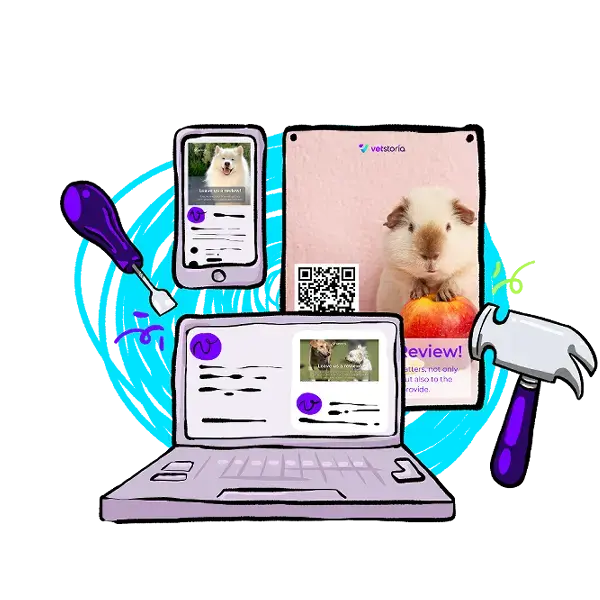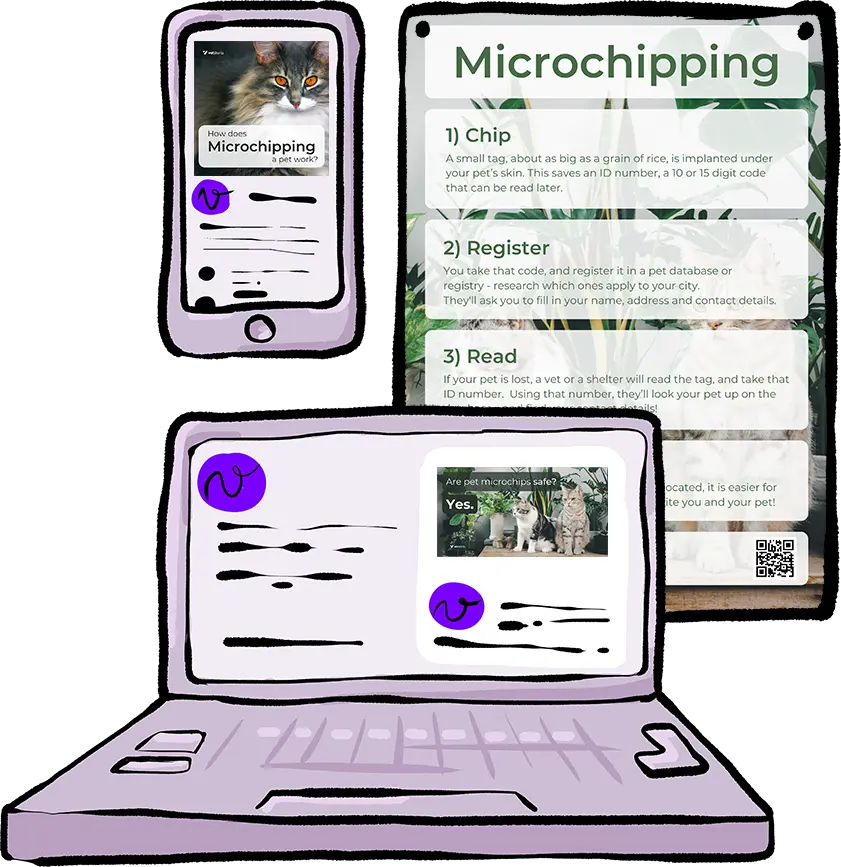Teach pet owners how to microchip their pet
This content pack helps you share important information with clients about microchipping their pets and encourages them to book their appointment with you! These packs are completely editable, and to save you even more time, we’ve included a pre-written email, and suggested captions for each of our social media templates.
Download our ready-to-use social assets:
Or brand the content for your clinic in 3 easy steps

Choose the pack you want, and open the clickable template links

Export the design as it is, or add your logo, brand colors, and update the text

Download the design for your digital channels, or print physical copies!
Customize the assets as you like:
What information is included in the Pet Microchipping pack?
Step 1: A small tag, about as big as a grain of rice, is implanted under your pet’s skin. This saves an ID number, a 10 or 15 digit code that can be read later.
Step 2: You use that code, and register it in a database. Fill in your name, address and contact details.
Step 3: If your pet is lost, a vet or a shelter will read the tag, and take that ID number…
Step 4: Using that number, they’ll look your pet up on the database – and find your contact details!
Step 5: They will contact you, and you’ll be reunited with your pet.
Pet microchips are tiny devices – about as big as a grain of rice – that store information. They don’t have a battery or source of power – just a chip, an antenna, and a “capacitor” which allows an external device to power the chip when needed.
When an “interrogator” device is used on the chip, it will send harmless radio waves, which the chip will turn into energy.
The chip will then use this energy to emit its unique ID number. This ID number can then be used to identify your pet, and look them up on a pet database. Your contact details will be stored in an online pet database – not on the pet’s microchip!
This means you can update your details whenever needed, such as if you change homes or phone numbers, without having to touch the chip. Updating your details does not require you to go to the vet, or replace the chip. The chip will be safely under your pet’s skin for the rest of their life!
Yes, pet microchips are 100% safe. The devices are small, bio-compatible (allergy-proof), and don’t have any kind of battery or power source. Inserting the chip under your pet’s skin is a very quick, non-invasive process – about the same as delivering a vaccine.
The chip has no parts that need to be maintained or replaced, which means that once it’s inserted, there is no need to touch it again – it’s in there for life. It’s the equivalent of tattooing a barcode on your pet, only even safer. Most importantly, it will enable your pet to be returned to you in case they get lost or stolen.
Microchipping your pet will allow your pet to be returned to you, should they become lost or stolen.
There are pet devices that can be programmed to respond to your pet’s specific chip – such as a pet flap that only lets your pet through, or feeders that only allow one of your pets in (which are very useful if you have multiple pets in the household with different, or even medicated, diets). Having your pet microchipped will open up many technological possibilities.
Microchipping your pet is a legal requirement in many places – including many US cities, and for dogs and cats in the UK. If you plan on traveling internationally, you will likely need to microchip your pet with a standard 15-digit ISO-compliant microchip.
You need to keep your pet’s microchip details up to date. That means you have to update your details every time they change – rather than at a specific time interval.
Always update your pet’s microchip details when moving homes (change your address), getting a new phone (confirm the number is correct), or when changing email address
The pet’s microchip details will also need to be updated if the pet has a new owner. In the process of adopting or buying your pet, you need to ensure the chip has been updated with your details.
Always keep your pet’s microchip details up to date! If your pet is lost or stolen, having an out-of-date phone number or address will make you much harder to contact.
Did you know that it is now a legal requirement in the UK to have your cat microchipped? (It has been mandatory for dogs since 2016.) Owners have until 10 June 2024 to microchip their cat. Failure to comply may incur a fine of up to £500.
Our Content Pack Calendar has all the marketing assets you need for the rest of the year neatly mapped onto a calendar. It’s been specially designed to help you have the most engaging, productive, and profitable quarter yet for your veterinary clinic. Download 2023 Q4 calendar here!

Get Vetstoria Content Packs direct to your Inbox
Vetstoria users get more, with online booking links and QR codes

Build online booking campaigns
Create promotional booking campaigns (like free dental check ups!) that follow set scheduling rules based on your preferred dates, the availability of vets, and more!

Add trackable booking links and QR codes
Use trackable links in emails, SMS, social profiles, online ads and in the clinic to promote your campaigns and easily measure the results.

Use analytics to optimize results
See how many appointments and new clients are generated from each campaign, and learn which channels are most effective.

Build online booking campaigns
Create promotional booking campaigns that follow set scheduling rules based on preferred dates, the availability of vets, and more!

Add booking links to digital channels
Use trackable booking links in emails, SMS, social profiles, and online ads to promote your campaigns and easily measure the results.

Use analytics to optimize results
See how many appointments and new clients are generated from each campaign, and learn which channels are most effective.


